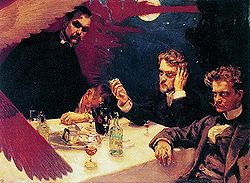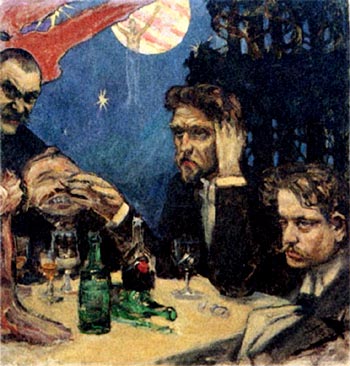

Persons in the paintings from left to right are Akseli Gallen-Kallela, Oskar Merikanto, Robert Kajanus and Jean Sibelius.
Having studied art in Paris in the 1880s, Gallen-Kallela established a reputation for his powerful paintings portraying the Finnish identity. One of his greatest achievements was the series of paintings he made of the Kalevala, the Finnish national epic. The artist was held in high esteem among Finnish nationalists, but he was also very cosmopolitan. In the early 1900s he lived in three continents, painting in locations as far away as Kenya and the USA, where he worked on his last major work. He also established contacts with many famous artists and artist groups in Continental Europe.
In 1894 Akseli Gallen-Kallela painted "The Symposium" (figure below on the left hand side), meaning a meeting or gathering. It also refers to Symposion, the name of group of Finnish artists in which Gallen-Kallela was a leading figure. The artist himself can be seen in the upper left corner of the painting. The theme was inspired by an evening at the Hotel Kämp, where the artists often congregated. Here they could discuss their thoughts and ideas in a relaxed atmosphere. The original sketch for this painting is entitled "The Problem" (figure below on the right hand side).


Persons in the paintings from left to right are Akseli Gallen-Kallela, Oskar Merikanto, Robert Kajanus and Jean Sibelius.
When the painting was unveiled, people were scandalised by the drinking, and little thought was given to the symbolism of the work. On the other hand, everyone understood that Gallen-Kallela was a serious artist who did not create watered down art", says Leena Ahtola-Moorhouse, Chief Curator at Ateneum Art Museum in Helsinki.
Ahtola-Moorhouse explains that Gallen-Kallela wanted to impress with his art while at the same time revealing something of the creative process. In the sketch a "forest of meaning" can be seen in the background. This artistic element described the imagination of his colleagues. In "The Symposium" the wings can also be seen as symbolising the miracle of creation. Gallen-Kallela exuded optimism and creativity, and his work was consciously dramatic and full of shocking elements designed to provoke the emotions of his audiences. In addition to Gallen-Kallela, legendary Finnish composer Jean Sibelius and other young talented artists at the time were inspired by the national awakening to create something really new, something Finnish. The gatherings of artists at the Hotel Kämp were based on a genuine need and desire to exchange ideas.
"It was believed at the time that certain forms of art work in synthesis, each complementing the other. Accordingly, the creativity described in "The Symposium" also represents companionship and collaboration", Ahtola-Moorhouse explains.
The art of Akseli Gallen-Kallela can be admired today at either of the two atelier homes that the artist had built for himself: one in Ruovesi, Central Finland (built in 1895) and the other in Tarvaspää, on the border between Espoo and Helsinki (built in 1913). Tarvaspää houses the Gallen-Kallela Museum.
This article is part of Finland Convention Bureau's series "The Name on the Door", which presents famous Finns whose names can be found in the conference facilities provided by FCB members.
The article is written by Tuomas Myllylä.
Thanks to FCB for permission to use the text.